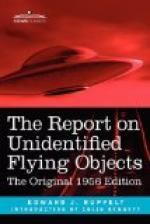The hassle over the word “proof” boils down to one question: What constitutes proof? Does a ufo have to land at the River Entrance to the Pentagon, near the Joint Chiefs of Staff offices? Or is it proof when a ground radar station detects a ufo, sends a jet to intercept it, the jet pilot sees it, and locks on with his radar, only to have the ufo streak away at a phenomenal speed? Is it proof when a jet pilot fires at a ufo and sticks to his story even under the threat of court-martial? Does this constitute proof?
The at times hotly debated answer to this question may be the answer to the question, “Do the UFO’s really exist?”
I’ll give you the facts—all of the facts—you decide.
July 1955, E. J. Ruppelt
CHAPTER ONE
Project Blue Book and the ufo Story
In the summer of 1952 a United States Air Force F-86 jet interceptor shot at a flying saucer.
This fact, like so many others that make up the full flying saucer story, has never before been told.
I know the full story about flying saucers and I know that it has never before been told because I organized and was chief of the Air Force’s Project Blue Book, the special project set up to investigate and analyze unidentified flying object, or ufo, reports. (Ufo is the official term that I created to replace the words “flying saucers.”)
There is a fighter base in the United States which I used to visit frequently because, during 1951, 1952, and 1953, it got more than its share of good ufo reports.
The commanding officer of the fighter group, a full colonel and command pilot, believed that UFO’s were real. The colonel believed in UFO’s because he had a lot of faith in his pilots—and they had chased UFO’s in their F-86’s. He had seen UFO’s on the scopes of his radar sets, and he knew radar.
The colonel’s intelligence officer, a captain, didn’t exactly believe that UFO’s were real, but he did think that they warranted careful investigation. The logic the intelligence officer used in investigating ufo reports—and in getting answers to many of them— made me wish many times that he worked for me on Project Blue Book.
One day the intelligence officer called me at my base in Dayton, Ohio. He wanted to know if I was planning to make a trip his way soon. When I told him I expected to be in his area in about a week, he asked me to be sure to look him up. There was no special hurry, he added, but he had something very interesting to show me.
When we got wind of a good story, Project Blue Book liked to start working on it at once, so I asked the intelligence officer to tell me what he had. But nothing doing. He didn’t want to discuss it over the phone. He even vetoed the idea of putting it into a secret wire. Such extreme caution really stopped me, because anything can be coded and put in a wire.




